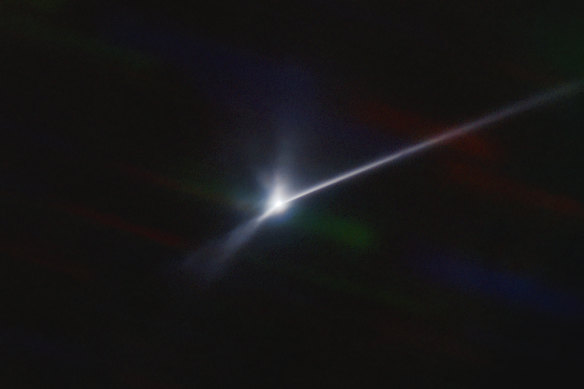NASA asteroid strike successful, results in big nudge, leaving long tail of debris

Cape Canaveral: A spacecraft that ploughed into a small, harmless asteroid millions of kilometres away succeeded in shifting its orbit, NASA said Tuesday in announcing the results of its save-the-world test.
The space agency attempted the first test of its kind two weeks ago to see if in the future a killer rock could be nudged out of Earth’s way.
A plume of dust and debris blasted from the surface of the asteroid Dimorphos by NASA’s DART spacecraft. The expanding, comet-like tail is more than 10,000 kilometres long.Credit:AP
The Dart spacecraft carved a crater into the asteroid Dimorphos on September 26, hurling debris out into space and creating a cometlike trail of dust and rubble stretching several thousand kilometres. It took days of telescope observations to determine how much the impact altered the path of the 160-metre asteroid around its companion, a much bigger space rock.
Before the impact, the moonlet took 11 hours and 55 minutes to circle its parent asteroid. Scientists had hoped to shave off 10 minutes but NASA Administrator Bill Nelson said the impact altered the asteroid’s orbit by about 32 minutes.
“This mission shows that NASA is trying to be ready for whatever the universe throws at us,” Nelson said during a briefing at NASA headquarters in Washington.
Neither asteroid posed a threat to Earth — and still don’t as they continue their journey around the sun. That’s why scientists picked the pair for the world’s first attempt to alter the position of a celestial body.
Launched last year, the vending machine-size Dart — short for Double Asteroid Redirection Test — was destroyed when it slammed into the asteroid 7 million miles (11 million kilometres) away at 22,500 kph.
The test cost $US325 million.
AP
Get a note directly from our foreign correspondents on what’s making headlines around the world. Sign up for the weekly What in the World newsletter here.
Most Viewed in World
Source: Read Full Article
